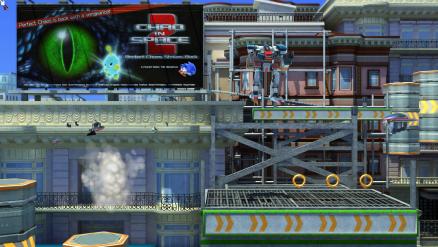
After several down years with title after title that failed to match the magic captured in the initial Sonic trilogy, it looks like Sega is finally poised to release a Sonic game that can stand near its original games in the lunch line without feeling ashamed.
[aditude-amp id="flyingcarpet" targeting='{"env":"staging","page_type":"article","post_id":297411,"post_type":"story","post_chan":"none","tags":null,"ai":false,"category":"none","all_categories":"business,games,","session":"D"}']Sega showed off the most recent title in its classic Sonic lineup, called Sonic Generations, at the Electronic Entertainment Expo today in Los Angeles, Calif. I got a chance to play through the first two levels on the Xbox 360 and the first two levels and a boss battle for the game on the Nintendo 3DS, and the game looks great.
I was a Sega kid growing up and the first four Sonic games are some of my all-time favorite games. I can say that many of the most recent Sonic titles — short of Sonic Colors and a few others — have been a bust. The first game for the most recent batch of consoles was critically panned, receiving a score of 46 out of 100 across 38 reviews on review aggregator site Metacritic. Sega’s most recent attempt to “sequel” the original trilogy with Sonic 4: Episode 1 was only met with moderate reviews, earning a score of 81 out of 100 across 13 reviews on Metacritic. Both games weren’t even close to what the first four games in the series were able to achieve.
AI Weekly
The must-read newsletter for AI and Big Data industry written by Khari Johnson, Kyle Wiggers, and Seth Colaner.
Included with VentureBeat Insider and VentureBeat VIP memberships.
Players in Sonic Generations take control of Sonic the Hedgehog, a speedy blue critter that can jump and curl into a ball that blows up everything in its path when it rockets through the level. The advanced version of the game introduces a “boost” feature, which lets the player immediately jump from standing still to running full speed with the press of the button and makes Sonic destroy every enemy in his path. He can also “lock on” to enemies and other objects in the levels and dash to them with the press of a button.
Inexplicably, Sonic Generations features a bit of both Sonic 4 and the 2006 version of Sonic the Hedgehog. The first level of each zone, called an “act,” plays more like the original sonic games and Sonic 4, running players through a two-dimensional side-scrolling level and only giving them access to a jump and ground dash. The second level plays more like Sonic the Hedgehog (2006), opening up the Boost and lock-on abilities. At face value, it sounds like a recipe that will repeat the previous titles.
In reality, the game plays very elegantly. The original Sonic games had excellent level design with multiple clever pathways and secret areas that lead to the finish line. Sonic Generations has pulled those design elements into the first level of each zone that plays like the original Sonic titles. The level that Sega demonstrated at E3 was the first level in the game, which was supposed to be a remake of the original Green Hills zone from the first Sonic game. It feels more like a re-imagining of the level and really evokes that same feeling of clever level design that the first games had.
Back to the Xbox 360 and PlayStation 3, the games invoke the same philosophy that Sonic Adventure did back when the Sega Dreamcast was first released. The camera sits behind Sonic as he blazes through a level at top speed. The controls are very simple — players tilt the control stick forward to run and hit a button to Boost and destroy enemies in his path. The Boost also works to let Sonic jet across the level at the top of his jump, giving players access to other parts of the level.
The second level of Green Hills features sonic blasting through the loop-de-loops, grinding on rails and running full speed from a giant robot fish. Where previous Sonic titles have tripped up is whether to send the player through the level full speed, keeping players on rails and taking away a lot of the challenge as they really only have to just hold the control stick up and jump a few times. The level I played in Sonic Generations was more challenging than that and it also bounces players back and forth between an over-the-shoulder camera and a two-dimensional platforming section.
[aditude-amp id="medium1" targeting='{"env":"staging","page_type":"article","post_id":297411,"post_type":"story","post_chan":"none","tags":null,"ai":false,"category":"none","all_categories":"business,games,","session":"D"}']
Sonic at one point was the unofficial rival to Nintendo’s iconic Mario, who has appeared in more than 100 games. That competition died off when the Sonic franchise petered out and when Sega finally admitted defeat with its last console, the Sega Dreamcast. And the Blue Bomber probably won’t ever give Mario a run for his money again. But Sega might have finally given new gamers a reason to give Sonic a second look after they polish off the latest Mario title.
Sonic Generations will come out sometime later this year and will be available on the Nintendo 3DS, Xbox 360 and PlayStation 3. 3D versions of the game will also be available for the PlayStation 3 and Xbox 360.
VentureBeat's mission is to be a digital town square for technical decision-makers to gain knowledge about transformative enterprise technology and transact. Learn More